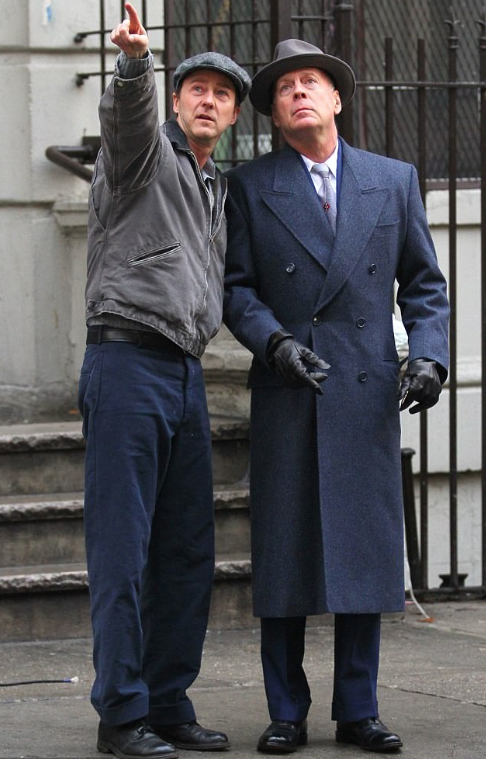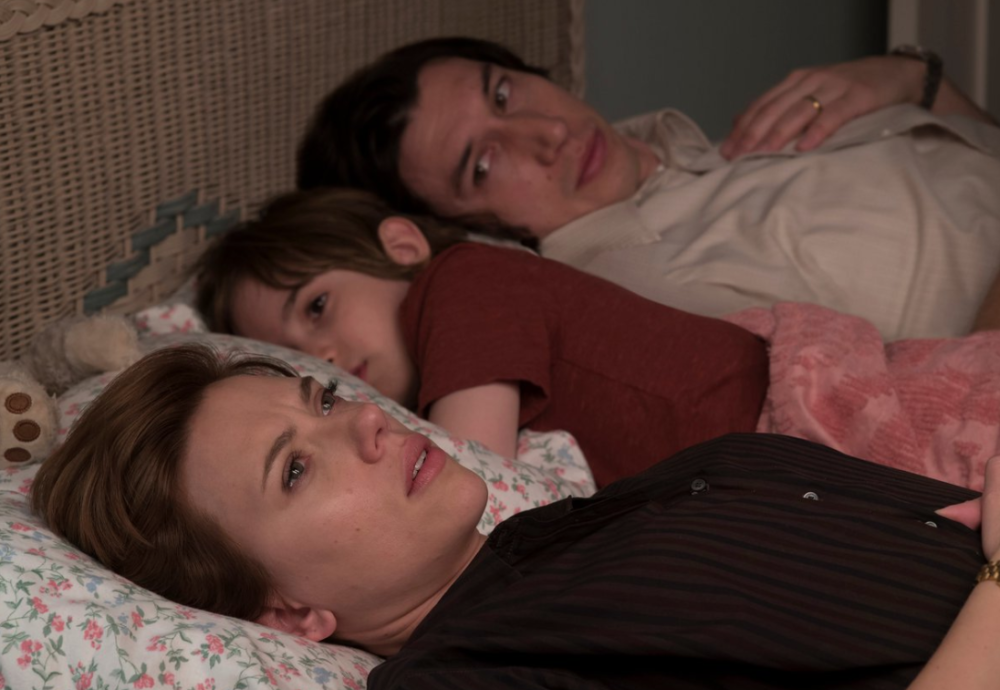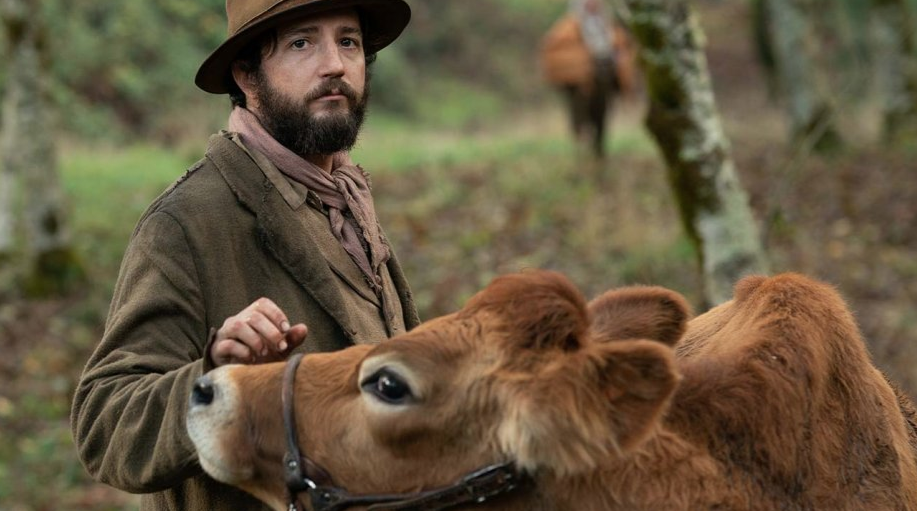An Amusement Column
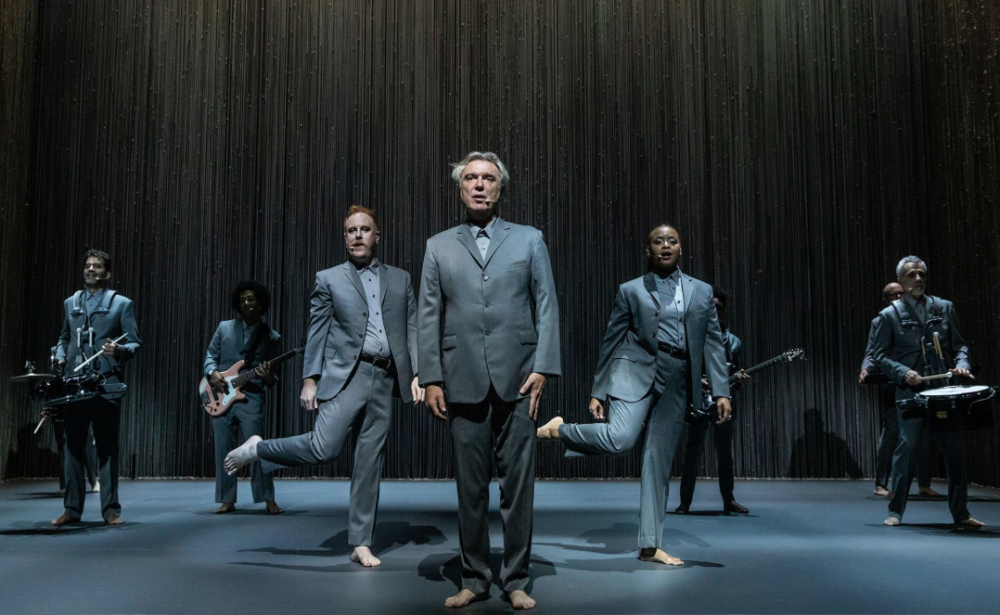
David Byrne, flanked by the two dancers in American Utopia – A freed band–and barefooted, too (photo Matthew Murphy)
by Harry Haun
AND THE BAND DANCED ON: The phenomenon of movable musicians marching on Broadway is set to occur Sunday night at the Hudson Theater—a barefoot band wearing gray flannel and various instruments hooked or harnessed to their bodies. Utterly unwired, gyrating about, they surround David Byrne in American Utopia, a theatrical concert version of his 2018 hit album by the same name. (Also, there will be detours to his heyday as Talking Heads front man and bits from his solo career.) . . . Truth to tell, only two of these will be trained dancers; the other nine encircling Byrne will be trained musicians who are taught dancers. There’s a difference, claims their teacher–the show’s incomparable choreographer and musical stager, Annie-B Parson—but she has high hopes they won’t show to the audience’s naked eye. . . . American Utopia has arrived on Broadway after an unnecessary out-of-town tryout in Boston, which was preceded by a yearlong out-of-country tryout that touched down 144 times all over the world. “Because this is from the rock tradition where you don’t really have directors,” says Parson, “David is inclined to avoid that word. It implies a play. In a sense, we would be that person together because the vision of the show is his and I’m executing it.” . . . Expressly for the NYC juncture, they’ve added Alex (Beetlejuice) Timbers to the mix as production consultant “to help David think about the interstitial moments of conversation with the audience. David’s always spoken between songs, but he wanted more shape and arc to it, so he’s turning to Alex’s expertise.” . . . It’s a reunion of sorts. These three creatives-–composer Byrne, choreographer Parson and designated director Timbers—were responsible for Here Lies Love, the biographical “poperreta” musical on Philippine first lady Imelda Marcos, that spilled all over one of the stages at The Public in 2013. “In that production, the audience was everywhere so there was no front,” Parson points out. “That was Alex’s doing and his hard work. In the case of American Utopia, it’s a proscenium piece. It doesn’t share that immersive quality with the audience. What it definitely does show is the kinetic relationship between the movement and the dance. Even more so, I would say. The audience dances a lot without being asked because the songs are David Byrne’s genius canon. Usually, they tend to get on their feet pretty soon.” . . . As soon as she makes her Broadway debut, Parson heads for Brooklyn’s Center for Performance Research where —as the Big Mama of the Big Dance Theater—she’ll do her 2019 Fall Technical Residency Oct. 21-27, preparing BDT’s premiere of The Road Awaits Us at Skirball on Nov. 8-9.
BEYOND THE PALE: The hyperkinetic character of Pale in Lanford Wilson’s Burn This is a restaurant manager, given to cocaine-snorting, after-hours rampaging and sex-led relationships—it’s the way he grieves for a drowned brother—and the last two actors to play him in New York filled the last two key slots of The 57th New York Film Festival. Adam Driver, who headed up a Broadway Burn This earlier this year, co-starred wth in NYFF’s Centerpiece attraction, Noah Baumbach’s bruising, poignant “love story of a divorce,” Marriage Story, while Edward Norton, who did the 2002 Off-Broadway revival of Burn This, starred in NYFF’s Closing Night offering, Motherless Brooklyn (a pitiful nickname hung on his character, Lionel Essrog, a gumshoe with Tourette’s Syndrome—now, that’s somebody we haven’t seen before!). . . Baumbach wrote his Marriage Story while the wounds were still fresh from his divorce from actress Jennifer Jason Leigh, so Driver (who’s not divorced) felt slightly sandbagged when he had to simulate a split with Scarlett Johansson. “Sometimes, in movies, there’s a scene that scares you that you know is coming up on the schedule—and it’s always too soon,” he says. “You feel like you don’t really have a sense of what you’re doing or what you should be wearing or how you should be walking. Sometimes, you find this before you start. Sometimes, you’re already two weeks in and then you have an idea where it is. Maybe it’s just a scene that seems unlike the others—whether more emotionally complex or more physically complex or just plain exhausting. For this movie, I felt every day was one of those scenes, which was a testament to good writing because the stakes were high in everything. Like, ‘Halloween is this week?—no, I don’t understand.’ Or, ‘The break-up is now?—getting served [divorce papers]?–that’s too soon.’ Every day felt like a major event. They all felt like too soon on the schedule.” . . . Marriage Story will do a month in theaters, starting Nov. 6, before going to Netflix exactly one month later. . . . Motherless Brooklyn, which goes into theatrical release on the first of the month, is a long (144 minutes) but holding and quite succulent detective yarn set atmospherically in New York of the 1950s. Shot in only 46 days, it points to some unsuspected skills of Norton, who was a genuine multi-taskmaster on this project: He adapted Jonathan Lethem’s novel, directed and co-produced it and played the title character who has a severe speech impediment. Inevitably, he was asked if he had bitten off more than he could chew. He took the high road. “There were times when I thought that maybe I should focus completely on the performance after I’d written the script,” he conceded, and he considered the advantage of being dealt a great hand. “Many of us have been inspired by people who’ve made a big film about the American character. What inspires me about Citizen Kane is that it treats people like adults. It assumes everybody is an adult. It assumes that people are smart enough to listen to a meditation on character. I remember talking to Warren Beatty about taking on something this big. I was scared of it, and he said, ‘People told me nobody wants to see [Reds], a three-hour movie about American socialism, with documentary footage from the era, and I said, ‘You know, I want to see it. It matters to me. I think it has something to say about who we are, and I’m going to do it.’ You can reflect on a film we now appreciate, but it helps me a lot to actually talk to people about how half-baked it felt and how many people told them they should not do this. That just helps you go through your own nervousness about the risks.” . . . The Beatty chat gave Norton the nudge he needed, and it made him think the film was, indeed, do-able, but he still had anxiety about his direction. “Actors help each other create a bubble of concentration within a highly technical process—and I was concerned about my negative impact on the quality of my ‘dance’ with other people, but my solution was easy. I specifically went to actors who, in their theater training and in their background and in the quality of their work, I knew would show up with very, very fully realized performances and need very little from me. I knew they would help me get back into an intuitive place, and they did. The cast of this movie was my own anchor as an actor. It was people I have deep relationships with, or, like in Gugu Mbatha-Raw’s case, whose work I was so drawn to, I knew we would have a good collaboration.” To name Names is like reciting the New York phonebook: Willem Dafoe, Cherry Jones, Alec Baldwin, Bruce Willis, Dallas Roberts, Bobby Cannavale, Fisher Stevens, Leslie Mann, Josh Pais, Joseph Siravo, David Negri and Stephen Adlay Guirgis, the sometimes-Pulitzer Prize-winning playwright.
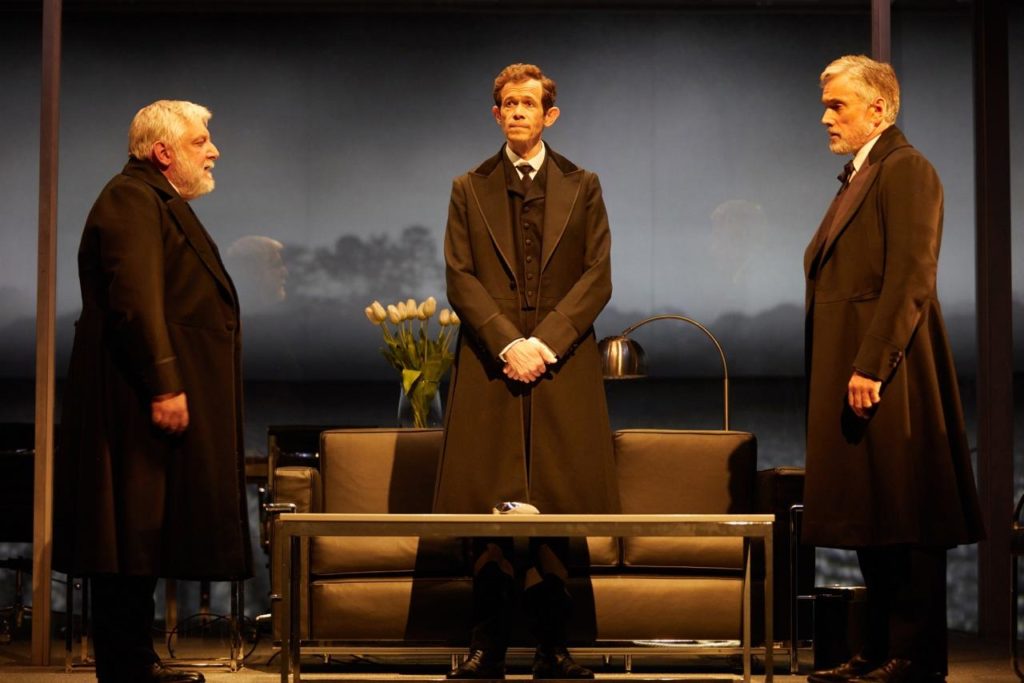

Simon Russell Beale, Adam Godley and Ben Miles in The Lehman Trilogy – from Bavaria to bankruptcy in 163 years
WHAT’S IN A NAME?: Three brilliant, classically trained Brits giving tightly wound Teutonic performances, that’s what—if we’re talking The Lehman Trilogy. That came to New York last spring (for a month at the Park Avenue Armory), is still playing around town (via National Theatre Live screenings at various outlets—the next is Nov. 1-2 and Nov. 22 at Symphony Space) and will return to do Broadway this spring (for 16 weeks at the Nederlander). . . . Stefano Massini’s ambitious three-act saga, translated into English from the Italian by Ben Power and directed by Sam Mendes, spans 163 years in the lives of an immigrant family—from their arrival on these shores from Bavaria in 1844 to their firm’s spectacular 2007 collapse in bankruptcy, which triggered the largest financial crisis in history. . . . Simon Russell Beale, Ben Miles and Adam Godley play not only The Brothers Lehman—Henry, Emanuel and Mayer—but also their sons and grandsons in performances so intricately interlaced that all three actors were squeezed into a single Best Actor Olivier nomination. Given the timing of the Broadway gig (March 7-June 28), it could happen again. We’ve already seen three Billy Elliots and four Matildas dance off with Tony Awards. When can the adults play? . . . At her New York Film Festival press conference, director Kelly Reichardt had some tall explaining to do about the movie she and Jonathan Raymond adapted from his novel, The Half-Life. It is now called First Cow and concerns a couple of friends who throw in with fur trappers roaming the Pacific Northwest of the 1820s. One of them comes across a cow in the dead of night, repeatedly milks her dry so he can rustle up some “oily cakes,” which the other friend peddles to the hungry populace. When their nocturnal activities are discovered, the locals view this as tantamount to cattle rustling. The festival moderator couldn’t help wondering how Reichardt got there when there is no cow and no milk in the source novel. “I can’t remember how that came about—I’m sure Jon thought of it,” she offered. “In the novel, [the trappers] take oil from beaver glands and take it across the ocean.” In Europe, the sweet-smelling substance that beavers use to mark their territory passes for perfume. Somehow, a cow compromise proved to be mercifully more photogenic.




